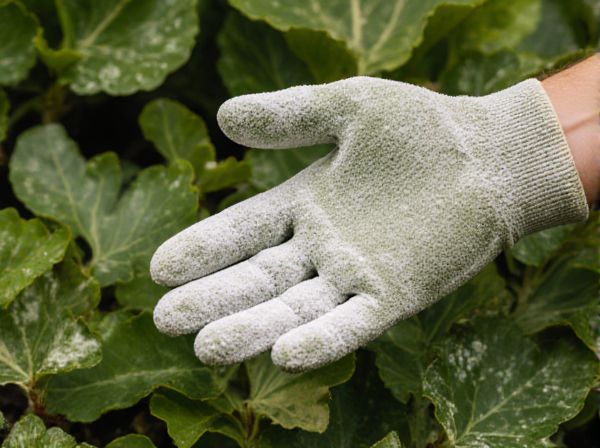
Powdery mildew vs Downy mildew Illustration
Powdery mildew and downy mildew are common fungal diseases affecting plants, but they differ in appearance and preferred conditions. Powdery mildew forms white, powdery spots on leaves and thrives in warm, dry environments, while downy mildew causes yellow or pale green patches with fuzzy, grayish growth underneath, favoring cool, moist conditions. Effective management requires accurate identification to apply targeted fungicides and cultural controls suited to each pathogen.
Table of Comparison
| Aspect | Powdery Mildew | Downy Mildew |
|---|---|---|
| Pathogen Type | Fungal (Erysiphales order) | Oomycete (Peronosporaceae family) |
| Symptoms | White powdery fungal growth on upper leaf surfaces | Yellow to pale green spots on upper leaves with downy growth underneath |
| Host Plants | Wide range: cereals, grapes, cucurbits, roses | Vegetables, grapes, cucurbits, and other susceptible plants |
| Optimal Conditions | Warm, dry conditions with high humidity | Cool, moist, and wet environments |
| Infection Type | Surface fungal mycelium without penetration of host cells | Intracellular growth causing tissue damage |
| Control Methods | Fungicides (sulfur, neem oil), resistant varieties, adequate air circulation | Fungicides (mancozeb, metalaxyl), crop rotation, improved drainage |
Introduction to Powdery Mildew and Downy Mildew
Powdery mildew is a fungal disease caused by species in the Erysiphaceae family, characterized by white, powdery fungal growth on plant surfaces, primarily affecting leaves and stems in warm, dry conditions. Downy mildew, caused by oomycetes in the Peronosporaceae family, appears as yellow or white patches on the upper leaf surface with a corresponding downy growth underneath, thriving in cool, moist environments. Both diseases significantly reduce crop yield and quality in crops like grapes, cucumbers, and lettuce, necessitating distinct management strategies due to their different pathogen biology and environmental preferences.
Key Differences Between Powdery Mildew and Downy Mildew
Powdery mildew primarily affects the surface of leaves and stems with white, powdery fungal growth, while downy mildew targets the undersides of leaves, producing yellow or pale green spots and a downy, grayish fungal growth. Powdery mildew thrives in dry, warm conditions, whereas downy mildew prefers cool, moist environments. The pathogens causing these diseases belong to different groups: powdery mildew is caused by Erysiphales fungi, and downy mildew by oomycetes from the Peronosporaceae family.
Symptoms of Powdery Mildew
Powdery mildew symptoms include white or grayish powdery spots on leaves, stems, and buds, which eventually cause leaf distortion and premature leaf drop. Infected areas may become yellow or brown, with affected leaves often curling or becoming brittle. The powdery fungal growth is most visible on the upper leaf surface, distinguishing it from downy mildew, which primarily affects the undersides of leaves.
Symptoms of Downy Mildew
Downy mildew symptoms include yellow or pale green spots on the upper leaf surface, often bordered by brown or purple margins. On the underside of leaves, a characteristic grayish-white to purplish fungal growth appears, which is a key diagnostic feature. Infected plants may exhibit leaf curling, wilting, and premature leaf drop, severely impacting photosynthesis and crop yield.
Causes and Conditions Favoring Powdery Mildew
Powdery mildew is caused by fungal pathogens from the genera Erysiphe, Podosphaera, and Uncinula, thriving in warm, dry climates with high humidity but minimal leaf wetness. Unlike downy mildew, which is caused by oomycetes and requires wet, cool conditions, powdery mildew develops on the surface of leaves under low moisture and moderate temperatures between 15-27degC (59-81degF). The disease proliferates in environments with poor air circulation and shaded areas, making dense plant canopies particularly susceptible.
Causes and Conditions Favoring Downy Mildew
Downy mildew is caused by oomycete pathogens such as Peronospora and Plasmopara species, thriving in cool, moist, and humid conditions with poor air circulation. These pathogens produce sporangia that germinate in the presence of water on leaf surfaces, promoting infection especially during rainy or dew-prone periods. In contrast, powdery mildew is caused by fungi like Erysiphales and prefers dry, warm environments, distinguishing it from the conditions favoring downy mildew development.
Plants Susceptible to Powdery Mildew vs Downy Mildew
Powdery mildew primarily affects a wide range of plants including grapes, cucumbers, and roses, thriving on leaves, stems, and flowers with white, powdery fungal growth. Downy mildew targets crops like grapes, lettuce, and spinach, causing yellow to brown irregular leaf spots with a downy fungal growth mainly on the undersides. Both mildews prefer different humidity and temperature conditions, influencing their susceptibility and prevalence in specific plant species.
Prevention Strategies for Both Mildew Types
Effective prevention of powdery mildew includes applying sulfur-based fungicides and ensuring adequate air circulation by spacing plants properly. Downy mildew prevention focuses on using resistant plant varieties, improving soil drainage, and applying copper-containing fungicides during wet conditions. Regular monitoring and maintaining plant health through proper watering and nutrition reduce the risk of both mildew types.
Effective Treatment Options: Powdery vs Downy Mildew
Effective treatment options for powdery mildew primarily include sulfur-based fungicides, potassium bicarbonate, and neem oil, which disrupt fungal growth on plant surfaces. Downy mildew requires systemic fungicides containing metalaxyl or chlorothalonil, targeting the pathogen within plant tissues to halt its progression. Integrated pest management incorporating crop rotation, resistant cultivars, and optimal irrigation further enhances control of both diseases.
Long-Term Garden Management for Mildew Control
Effective long-term garden management for powdery mildew focuses on cultivating resistant plant varieties, ensuring proper air circulation, and applying sulfur-based fungicides during early infection stages. Downy mildew control requires maintaining dry foliage through drip irrigation, removing infected leaves promptly, and utilizing phosphonate fungicides to inhibit pathogen growth. Consistent monitoring and integrating cultural practices with targeted chemical treatments help minimize mildew outbreaks and protect plant health sustainably.
Powdery mildew vs Downy mildew Infographic

 gardendif.com
gardendif.com